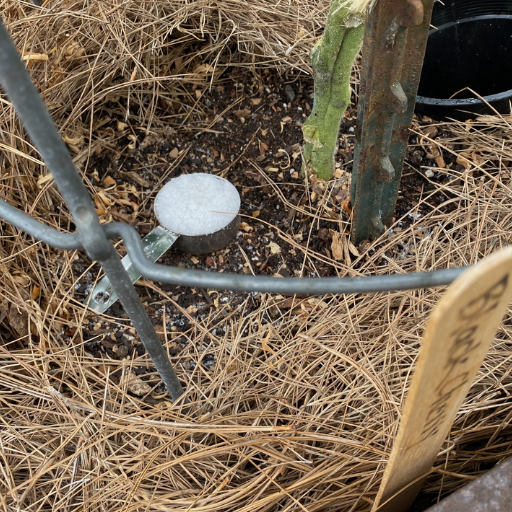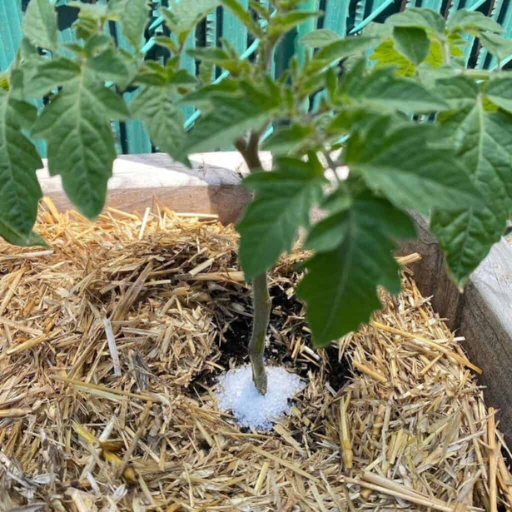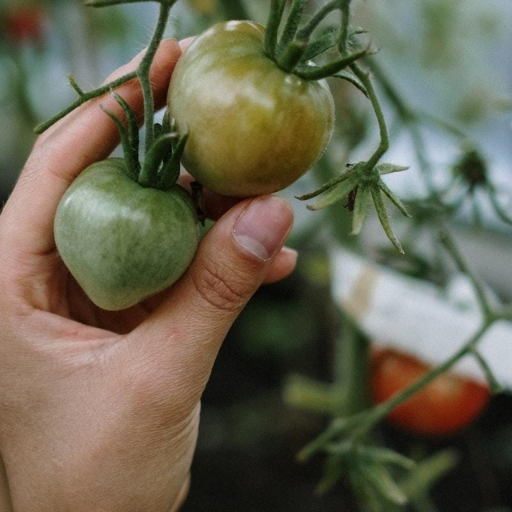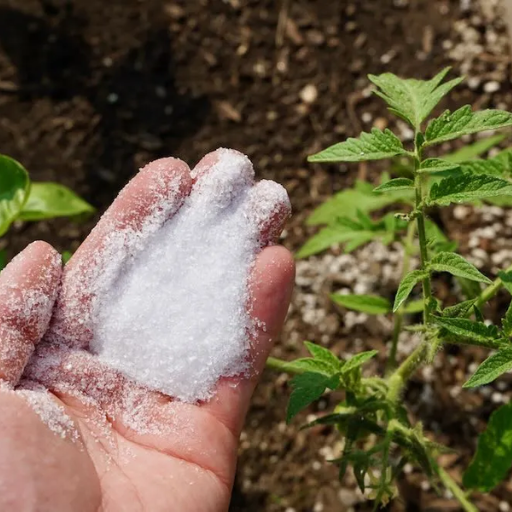A remedy for gardens that can increase the growth and productivity of tomato plants is Epsom salt, scientifically termed magnesium sulfate. This article examines the benefits of using Epsom salts in your garden and how to incorporate them into your gardening routine. We will also provide an application guide, the best time to use it, and the specific benefits it brings to your tomatoes. Whether you are an experienced gardener or not, you need to know how this essential but significant ingredient can give you healthier crops and yields that will make your labor in the garden fruitful.
What Are the Benefits of Using epsom salt on tomato Plants?

What is the reason for tomato plants requiring Epsom salt?
Tomato plants need Epsom salt, which contains magnesium and sulfur. Magnesium is essential for photosynthesis and plant energy production as it helps absorb sun energy. On the other hand, sulfur helps form amino acids and proteins, critical to providing plant structure and vigorous growth. By incorporating Epsom salt into your gardening routine, you can help prevent common nutrient deficiencies, promote better fruit quality, and enhance the overall productivity of your tomato plants.
How does magnesium in epsom salt benefit tomatoes?
There are some significant benefits of magnesium to the growth and development of tomatoes:
- Magnesium Makes Photosynthesis More Effective: This element is a key component of chlorophyll, which enables photosynthesis. It ensures that plants convert sunlight into energy, thus improving their productivity.
- Nutrient Availability: Magnesium enhances the availability of other essential nutrients, such as nitrogen and phosphorus. Therefore, it ensures that tomatoes have a well-balanced food supply for healthy growth.
- Fruit Quality Improvement: Magnesium influences the overall taste, size, and quality of tomatoes since it plays a major role in sugar-acid balance during ripening.
- Disease Resistance: The presence of enough magnesium will allow healthy growing plants to develop strong resistance against any type of disease or harsh environmental conditions.
Why these technical parameters:
- Amounts of Magnesium: Epsom salt contains around 9.8% magnesium by weight. The regular application significantly increases levels to keep the soil rich with this vital nutrient.
- Dosage rate recommended: Many experts have suggested that for optimal results, 1-2 tablespoons per gallon every four to eight weeks through the growing season is sufficient.
Thus, judicious use can create a favorable environment in which all health aspects related to tomato production, including high yield, can be realized.
Can epsom salt improve fruit production?
Epsom salt helps increase fruit output in different plants, including tomatoes, as I found in my research on the top gardening sites. Magnesium and sulfate are essential for several physiological processes occurring in plants that can affect nutrient uptake, fruit quality, and overall plant health. Many people have realized changes in their fruits’ size, look, or taste after following the correct procedure when applying Epsom salts. It is, however, advisable to use it sparingly since excess quantities might disrupt the nutritional balance of soils.
How do you use Epsom salt for tomato plants?

How to put Epsom salt into the soil?
To integrate Epsom salts efficiently into my tomato plantations, I employ a few simple tricks. Initially, I dissolve one or two tablespoons of Epsom salts in a gallon of water and use this solution to water my plants every four to six weeks during the growing season. This method guarantees magnesium and sulfate reach each root, resulting in an even distribution of these elements. Again, at the commencement of growth seasons, I often sprinkle dry Epsom salts around the base of my plants, gently mixing them with the topsoil. When watering my tomatoes, I make sure that salt is slowly incorporated. Lastly, adding Epsom salts to my compost pile has also been a beneficial way of enriching my crops with nutrients over time. Applying these techniques has led me to observe better growth and increased fruit quality.
So, how do you dissolve epsom salt in water?
The dilution depends on what most gardening websites advise, according to which I generally adopt a simple ratio. I usually dissolve 1-2 tablespoons of Epsom salts in 1 gallon (about 3.8 liters) of water. Such a mixture effectively delivers magnesium and sulfate to my plants as required. To be accurate about how small amount does not exceed 15mls that I can apply, usually, it is measured using a tablespoon explicitly made for this purpose involving pure sodium chloride.
This can be done every four & to six weeks, depending on the stage at which your tomatoes are growing…. This helps ensure that the salt dissolves fully because warm water speeds up the rate at which dissolution occurs and helps in its rapid uptake by plants through osmosis, thereby enhancing their absorption process….. Complying with these technicalities leads me towards improved crop production, such as increased size plus quantity and, hence, higher yields for all tomato harvests.
How can Epsom salt spray be used as foliar feed?
To effectively apply Epsom salt through foliar feeding, I follow these concise steps based on the advice from top gardening websites:
- Making the Solution: First, I dissolve one tablespoon of Epsom salts in warm water in one gallon (approximately 3.8 liters). Warm water makes the salts dissolve faster, and they can easily be absorbed by the leaves.
- Timing: To avoid nutrient loss due to evaporation, I apply my solution either early morning or late afternoon during cooler temperatures. This allows for more nutrient absorption before high daytime heat.
- Application Method: Using a spray bottle or garden sprayer, I evenly and thoroughly mist the leaves to cover both sides with moisture. A light, even coating rather than a saturating drench helps enhance absorption while avoiding damage to foliage.
- Frequency of Application: Finally, I use this foliar solution every four to six weeks throughout my plant’s growth cycle for continuous magnesium and sulfate supply.
- Observation: Lastly, after applying the feeding treatment, look at the plants. If leaf color deepens or fruit production increases, then it is clear that the feeding treatment was successful.
By following these steps and using recommended mix ratios, I have observed great benefits in my crops, thus supporting their fitness in terms of health throughout growing seasons.
How Much epsom salt Should Be Used for Tomato Plants?

Suggested amounts of Epsom salt per plant
On average, I advise using a tablespoon of Epsom salt for each tomato plant. As previously discussed, this can be mixed with a gallon of water or applied directly to the soil as a top dressing. Sometimes I can vary this amount to 1-2 tablespoons for larger or more mature plants. Moreover, during the early development stages, such as when they start to flower, I have found that incorporating Epsom salt improves nutrient intake and overall fruit quality. Always observe the behavior of plants and adjust them accordingly in case of any signs of stress or nutrient deficiencies.
How often should epsom salt be applied?
Epsom salt should be applied every 4-6 weeks throughout the growing season for tomato plants based on my experience and guidelines given by most renowned gardening blogs. This timing corresponds with the nutritional requirements of these plants, especially at crucial stages of their growth cycle. They include:
- Initial Application: Once flowers appear on the tomato vines, I apply Epsom slats, which supply enough magnesium to enable photosynthesis and enhance fruit quality.
- Frequency: After every 4-6 weeks, according to schedule, nutrients may keep leaching without causing over-fertilization.
- Adjustment: I interpret how plants respond and change frequency if necessary; therefore, if there are any deficiencies—examples being yellow leaves or weak fruiting — it would depend upon my observations while staying within this range.
This structured approach helps promote better growth rates while ensuring maximum nutrient absorption all year round.
When should we use Epsom salt for tomato plants?

When is the best time to use epsom salt?
The right time to apply Epsom salt to tomato plants is during their first flowering stage. This is important because it gives them enough magnesium to help them develop healthy fruits. Based on suggestions from several leading gardening websites, I also tend to reapply Epsom salts halfway through the season, especially when there are signs of a lack of magnesium in the plant, like yellowing leaves. This will jump-start early development and sustain those developing critically, guaranteeing good yields.
Signs That Your Plants Need Epsom Salt
From my experience growing tomato plants, some indications show they need Epsom salt. The most frequent warning symptoms include:
- Yellowing Leaves: The plant needs more magnesium when mature leaves turn yellow while veins remain green from the bottom up. The symptom usually starts with older leaves as magnesium is moved by the plant for newer growth.
- Poor Fruit Set: If your flowers are falling off before they bear fruits or if you observe deformed, unhealthy, or rotting fruits, this suggests a magnesium deficiency needed for proper fruit production.
- Stunted Growth: Inadequate amounts of magnesium can lead to retarded plant growth. If your tomatoes appear stuck in one growth stage with no upward or outward movement, then it could mean a lack of Epsom salt.
The advice from top gardening sites suggests watching out for these symptoms, as they can affect overall yield. To correct such deficiencies, I usually administer 1 tablespoon dissolved in 1 gallon of water around each base individually, ensuring evenness around every plant’s foundation. This approach not only rectifies nutrient imbalances but also assists in maintaining a favorable growth environment throughout the planting period.
How to Identify Magnesium Deficiency in tomato Plants?

Symptoms of magnesium deficiency in tomatoes
In my opinion, the symptoms of magnesium deficiency in tomato plants can be very revealing. I have noticed that the most common indication is the yellowing of older leaves, which usually show up in green veins to indicate that they are drawing out magnesium for the growth of new ones. Secondly, poor fruit sets involve flowers that drop off prematurely or do not grow into fruits, which means they need more magnesium. Finally, there is a significant concern about stunted growth at large; a tomato plant that does not grow as it should may necessitate an Epsom salt–based boost for magnesium. I have managed to maintain healthy and productive plants by continuously observing these symptoms.
How do you test for soil’s level of magnesium?
To check for the level of magnesium in the soil, I typically follow a straightforward procedure based on information from top gardening websites. Initially, I collected soil samples from various places where I planted my tomatoes to ensure accurate results. Then again, one can employ a specific soil testing kit to check magnesium levels stocked at garden centers or found via online platforms. By using this kit and mixing this solution with my soil sample as instructed, it becomes easy to establish the amount of Magnesium through comparison. If such amounts appear low, I immediately adjust my fertilizing approach to meet their demand and ensure a high yield.
Reference sources
Frequently Asked Questions (FAQs)
Q: What is the benefit of using Epsom salt in tomato plants?
A: Epsom salt can help tomato plants by giving them magnesium, an essential nutrient. This improves photosynthesis and overall plant health.
Q: How can Epsom salt prevent blossom end rot in tomatoes?
A: While Epsom salt isn’t a direct solution for blossom end rot, it helps by providing magnesium. A calcium deficiency causes blossom end rot, and proper overall nutrition can help prevent it.
Q: How do I use Epsom salt for plants in my vegetable garden?
A: You can use Epsom salt directly by mixing one tablespoon with a gallon of water to create an Epsom salt solution. This solution can be used to water the plants or as a foliar spray.
Q: Should I perform a soil test before adding Epsom salt to my garden?
A: It’s recommended that a soil test be performed to check for magnesium deficiency. This will help you determine if your plants need the addition of Epsom salt.
Q: Can Epsom salt help improve the growth of pepper plants as well?
A: Epsom salt helps peppers and tomatoes grow better by providing magnesium, essential for plants’ development.
Q: Can I add too much Epsom salt to my soil?
A: Yes, adding too much magnesium can be harmful to plants. It’s important to follow recommended guidelines and avoid over-application.
Q: How can I help the salt dissolve better in water when making an Epsom salt solution?
A: Use warm water to help the salt dissolve more effectively, ensuring an even distribution when applied to your plants.
Q: What are the signs that my tomato or pepper plants are deficient in magnesium?
A: Common signs include yellowing leaves with green veins. If these symptoms appear, Epsom salt can improve the plants’ condition.
Q: Are there any vegetables other than tomatoes and peppers that benefit from Epsom salt?
A: While Epsom salt is particularly beneficial for tomatoes and peppers, it can also be used for other vegetables. However, always check specific requirements for each type of plant.
Q: How often should I apply Epsom salt to my garden?
A: It’s generally recommended that you apply Epsom salt solution every two to four weeks during the growing season. Adjust the frequency based on your specific plant needs and soil conditions.







